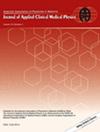Commissioning evaluation of a deviceless 4DCT scanner
Abstract
Background
The utilization of four-dimensional computed tomography (4DCT) for radiation therapy has not seen major advances to the method of data binning since shortly after inception. Recently there is increased interest in the utilization of an alternative binning method rather than more established techniques. At this point routine quality assurance and commissioning of 4DCT have been well studied and established with traditional binning methods. Due to this new “deviceless” technique relying on algorithms instead of an external breathing signal, established dynamic phantoms and equipment typically used in the commissioning and quality assurance workflow have proven to no longer be compatible.
Methods
A commercially available phantom was modified to include components that the deviceless 4D algorithm uses for binning. Typical 4DCT commissioning datasets were acquired and reconstructed using both deviceless and device-based binning techniques. Both regular and irregular breathing curves were evaluated for performance, similar to what would be seen with typical radiation therapy patients.
Results
Deviceless and device-based binning methods performed similarly and well for regular breathing curves. As datasets became more irregular, the deviceless algorithm was better able to reconstruct 4DCTs.
Conclusion
Commissioning datasets for both device-based and deviceless 4DCTs were evaluated to test if modifications to a commercially available phantom would allow for an accurate comparison between binning systems. It was shown that not only did these modifications work but also highlighted a difference in the way that these systems binned data, which could be applied to patients with breathing irregularities.


 求助内容:
求助内容: 应助结果提醒方式:
应助结果提醒方式:


